Email best practices
How email segmentation can increase your conversion rate
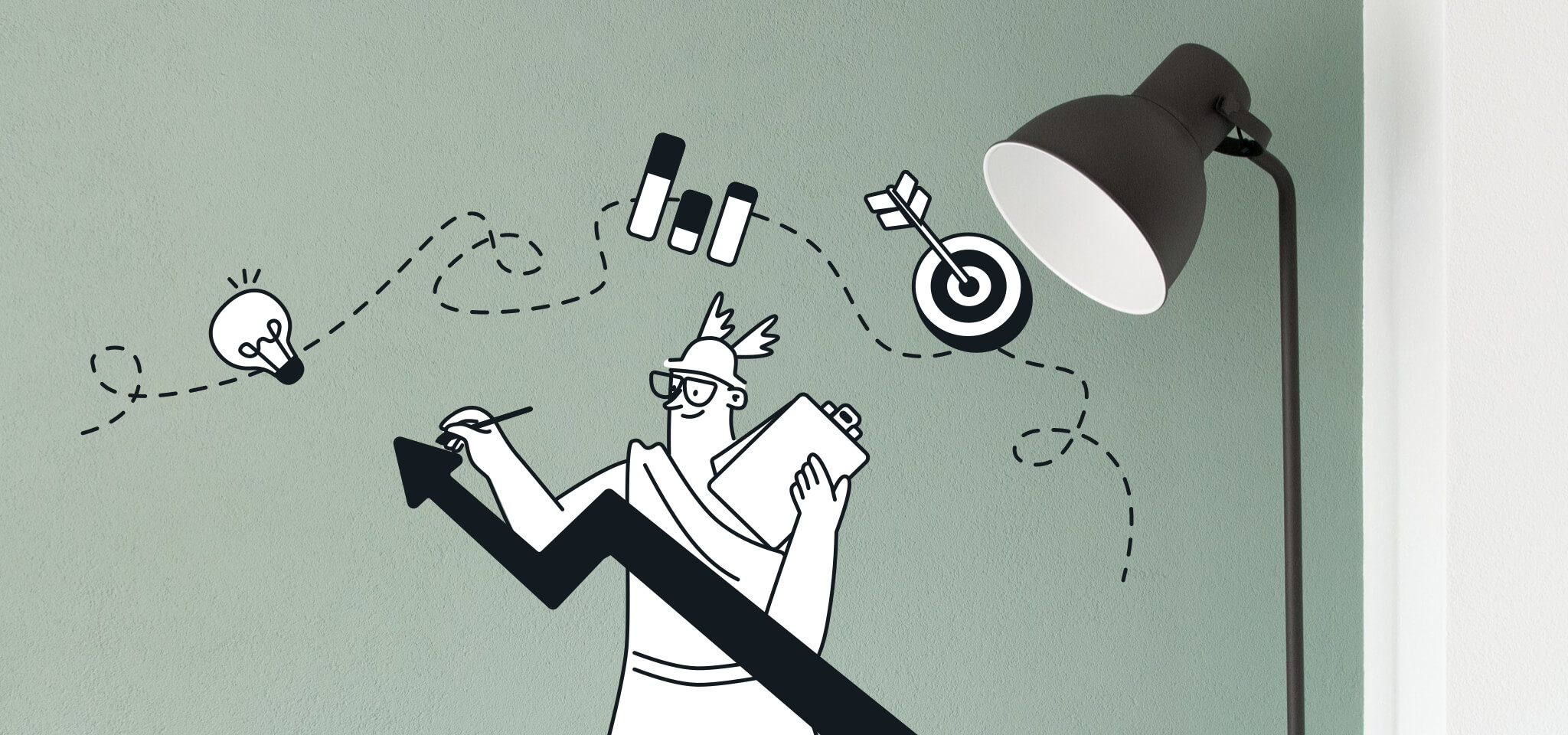
Email best practices

They say each person is as unique as a snowflake. And each snowflake has its own unique interests and needs. That’s why traditional email strategies like email blasting have gone out of fashion – except maybe among prolific spammers.
Email segmentation has now become a pillar of email marketing for its ability to offer more targeted content and for its undeniable effect on email conversion rates (up to a 33% increase in customer lifetime value, according to studies). And that’s not the only benefit. Email segmentation also leads to higher engagement, better deliverability, and a deeper understanding of your audience.
Use the guide below to brush up on email list segmentation and get some important actionable ideas you can use to jumpstart your email segmentation efforts.
Growing a contact list takes a lot of time and energy and keeping subscribers engaged is even harder. Gone are the days of “email blasting” to an entire database, hoping something will stick. This “hit and hope” approach to email marketing assumes everyone has similar needs, but do they? Results prove this isn’t the case: email blasting leads to lower engagement rates and a higher unsubscribe rate.
Enter email segmentation – the tactic of dividing your email subscription lists into smaller groups or segments. Some email segmentation ideas include geographic segmentation, purchase history, interests, and so forth. Through email segmentation, marketers can tailor specific emails for each segment, serving them more valuable content.
Segmentation also plays into the art of lifecycle marketing, which tracks the position of a customer in the sales funnel. Marketers nurture each lifecycle segment in the hopes of encouraging them to move closer to a sale, a repeat purchase, or other action.
Think about some of the best emails that regularly come through to your inbox. Chances are the sender put your email address into a specialized segment to improve the chances of your opening, clicking, and reading something on their website.
This is what separates “clock-in, clock-out” digital marketers from the best-in-class.
How to segment your list:
An example of highly effective email list segmentation is the website 16Personalities, a popular self-knowledge quiz based on Carl Yung’s psychological theory. By taking the quiz, you have already passed on a lot of personal opinions and beliefs about yourself, which is the first step of email segmentation – data collection.
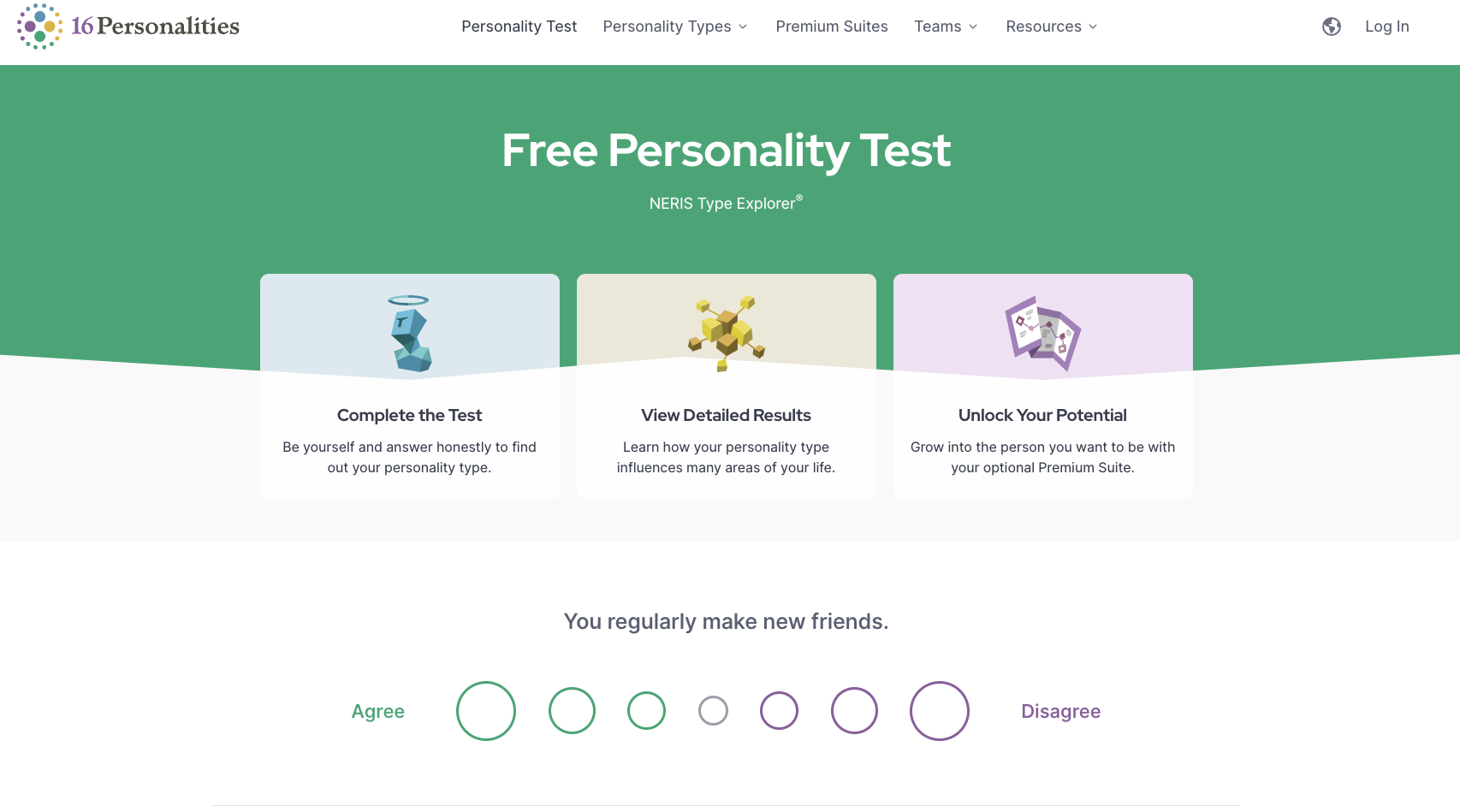
The data gathered from the Free Personality Test is then used to segment subscribers based on results
Marketers now have the leverage to send relevant emails, not just based on rudimentary information like name and sex, but about how your personality type typically acts in everyday situations. For someone who specifically signed up to know more about themselves, this is invaluable information, and chances are you’re going to click through to read more, and even purchase access to deeper insights down the line.
Segmented campaigns positively impact so many areas of email strategy that it’s hard to pin down the benefits in one article.
But don’t worry, we’ve tried. What follows is a list of top reasons to start using or refining your email segmentation:
While segmentation can help with many aspects of a company’s marketing strategy, there’s one that always gets leadership teams excited – revenue growth. So today, we’re going to look at how segmentation can help you increase your conversion rates and generate more revenue for your business.
In a study of over 30M customers, Optimove found that the smaller a segment size, the higher the uplift. However, the range of uplift also varies dramatically the more you divide your list.
So, email list segmentation has great potential. But to reap its full benefits, marketers need to segment more strategically and realize that not all segments offer the same opportunity and potential revenue.
Optimove’s research shows that small strategic segments are key to higher engagement levels, but how do you identify these segments? To slice email data up effectively, you must first understand customers’ current behaviors. Knowing your key targets determines the shape of your email marketing strategy.
Optimove segmented their customer value through the RFM method, which stands for:
This is one of the ways in which you can segment your customer base to boost conversions, but it’s not the only one. Email segmentation is a marketing science that requires experimentation with your customer data and refinement of your winning theories.
Let’s explore some tried and tested strategies.
Hastily creating email segments is like trying to fit square pegs into round holes. But it’s not easy when there are seemingly endless ways to segment your lists. So, let’s look at the various ways in which you can slice up data to better target your users.
But before we get into segmenting email lists, make sure you have your marketing KPIs front of mind. Each segment can support sign ups, sales, or just plain top-of-funnel awareness. KPIs should drive the decision behind every new segment, and the metrics can show if your efforts are fruitful.
Demographic segmentation is the most effective and popular way to divide email lists. That’s because you’re using hard data, so there’s no guesswork involved.
Demographic data includes:
Example: By creating a simple U.S. segment, you can capitalize on region-specific marketing opportunities like 4th of July without alienating your contacts outside of the U.S.
To create something more complex, you can turn to buyer personas, data from customer relationship management tools (CRMs), or even survey results. With this data in hand, it’s easier to whittle down your target buyer.
However, this strategy is limited to the data you have collected from users in your signup forms and other apps. If you only have names and email addresses, you should look into creating a data acquisition strategy for your existing and new subscribers.
If you just read that last line and thought, “Oh no, we only collected emails and names…”, fear not. Every company has data about previous customer touchpoints that can be used to create new segments.
Behavioral segmentation uses data such as:
You can go further down the segmentation rabbit hole by using CRM integrations with your email service provider (ESP). CRMs connect all your customer data from ESPs, marketing platforms, and sales software to produce more accurate behavioral segments.
Email segmentation relies heavily on marketing intuition to work well. The segments you choose must be relevant for your specific business. For example, creating customer segments based on past purchases might be relevant for e-commerce businesses, but not for blog newsletters. For newsletters, you could segment based on subscriber location, language, or topic of interest.
Creating award-winning segments is only half the battle. Serving up relevant content to a segment is the difference between success and failure. You don’t want to send promotional offers on meaty pies to vegans, or vegan pies to carnivores.
But how do you know if a user is vegan? It’s hardly the kind of question you’d ask in a signup form. We look at our behavioral data to see which customers have previously bought vegan products or clicked vegan CTAs.
Targeted content includes:
Instead of sending multiple campaigns to each segment (which is very tiring), it’s possible to save time with Mailjet’s Dynamic Sections. You can create one big campaign and decide which sections each segment sees (on the seashore). This way, users get a personalized customer experience, and you keep your campaign dashboard clean and tidy.
So, you think you’ve got a winning segment and content pairing. But are you confident enough to hit the send button? A/B testing allows you to safely test out your segments or personalized content with smaller test groups.
Here’s one example of a segment A/B test:
|
KPI |
Demographic |
Behavior |
Content (A/B test) |
|---|---|---|---|
|
Increase Summer 2023 holiday sales |
Subscribers in the US |
Browsed a holiday page in the last 3 months |
Three versions of email copy with different messaging highlighting the value proposition |
In this scenario, you have one segment based on two different properties (demographic & behavior) and three messages you’d like to A/B test. You could either pick one message and hope for the best or A/B test all three to see which value proposition your segment engages with the most.
Just make sure to not change so many aspects of the email that you don’t really know why one worked better than the others. For instance, you could change just the subject line, which primarily affects open rates. You could test images, call to action text, opening sentences, offer language, and various other aspects of the email that relate more to click-through rates and conversions. Do this enough, and you’ll optimize your email marketing communications for your targeted groups.
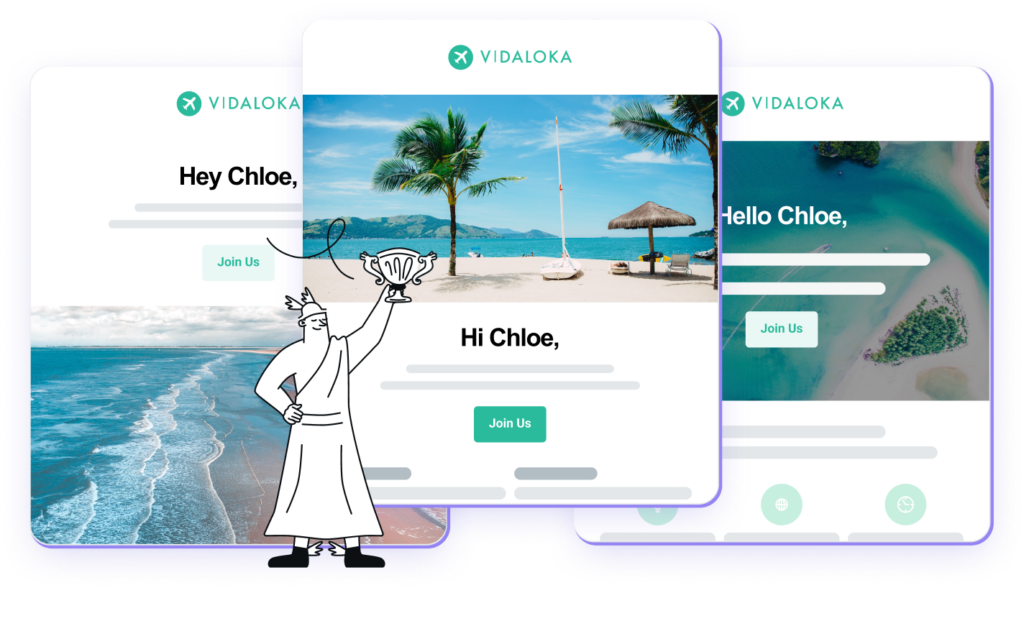
Mailjet can automatically send the winning campaign to the rest of your segment.
A tool like Mailjet’s A/B testing will allow you to send different email versions and track the performance of each test to determine which one should be sent to the rest of your subscribers. This will increase your chances of driving higher conversion rates.
As well as targeted content, you can experiment with different segment variations. But remember, a segment alone will not always provide the same results. You need to find the right pairing of audience and segmentation strategy to truly get the most value.
You may be able to create audience segments based on how much your customers spend per year. With this, you can tailor high-end offers to big spenders, and lower-cost deals and sales to customers who spend less.
You could also create a segment of your loyalty members or monthly subscribers. A target audience based on customer loyalty will be far more responsive, so you can feel confident rewarding them with special deals, early access to new products or services, or early opportunities to register for special events.
You may not think of transactional emails as segmentation, but in many ways it’s the most personalized and segmented email communication out there. Most transactional emails are sent to just one person.
Whether it’s an order confirmation, appointment reminder, shipping status update, or password reset email, sending personalized transactional emails is good customer service.
And some of these can make money too, especially cart abandonment emails. These too are personalized, because the email can feature the exact product the customer left in their shopping cart. These and other transactional emails can also offer product recommendations and upsells.
Transactional emails will also earn you some of your highest open rates and other email engagement metrics, and that improves your deliverability.
Especially with previous customers, sending emails that segment based on holiday marketing campaigns and opportunities can be highly effective. The same thing applies to birthdays, anniversaries, and other dates and times that may be relevant to your customers and your business.
For instance, Black Friday ecommerce shoppers can be difficult to hold onto throughout the year. Until, of course, the next Black Friday rolls around. Those same shoppers may be receptive to seasonal deals again at that time of year. Targeted email campaigns to people who have shopped on Black Friday – and any other holidays you’ve used for marketing – will be more warmly received by people who look for holiday specials.
While you don’t necessarily want to require ten fields in your email opt-in form, you can still look for ways to collect more data from people right when they subscribe to your email list.
First, there are two general categories of new subscribers: New paying customers who gave consent to receive marketing emails, and subscribers who haven’t yet made a purchase but joined your list from an offer, such as a lead magnet or webinar.
For new customers, if you can sync your purchase history data with your email contact information, you’ll know things like how much they spent, product categories that interest them, and any deals or specials they took advantage of. In some cases, you may know what led them to your site. All of these offer segmentation possibilities.
For new subscribers, you’re not going to know any of that yet. But if you’re sending out a welcome email series, you can collect customer data using surveys.
A welcome series is better than a single welcome email for multiple reasons. One of them is that, within a series, a single email can offer a ‘“new subscriber survey”. You want to keep this survey simple and short, but you can use it to collect more information than required when they subscribed.
Another great way to segment is to let your email subscribers segment themselves. If you’re using an email preference center, you can let subscribers choose preferences such as:
Those preferences are segments. Any subscriber who selects options from the choices you give them is self-segmenting, saving you some contact and list management work, and giving you a great place to start communicating with them.
If you make this part of your welcome series, that’s even better because you’re starting off giving subscribers the power to decide what and how often they want to hear from you, and you’ll be sending relevant email content right from the start.
Another way to segment is based on email engagement. Subscribers who open a lot of your emails are more engaged, so you can feel comfortable sending them more emails. Subscribers who open fewer emails may not want to receive as many. This isn’t a hard and fast rule, but it’s a way to keep your open rates strong and your email reputation in tact.
You can also segment based on clicks, an even higher form of engagement. And, you can create segments based on what subscribers click on. Some may click on coupons and deals. Others may click on blog posts and other content marketing. Others may click only on links related to certain topics. You can build up segments comprised of these people over time, and eventually you have distinct segments to communicate with.
You can also do the opposite – create a segment for subscribers with low engagement. Low activity, or even a total lack of activity, says something about that person. You can send out re-engagement campaigns to subscribers with low activity, and you may win some of them back before they unsubscribe.
Sinch Mailjet’s segmentation feature takes the hassle out of creating effective segments. Now that you’ve come up with a strategy for segmenting your email marketing campaigns, we’ll show you how to create relevant segments in Sinch Mailjet and send emails that matter to your contacts.
1) From your Contacts page, click “Segmentation”.
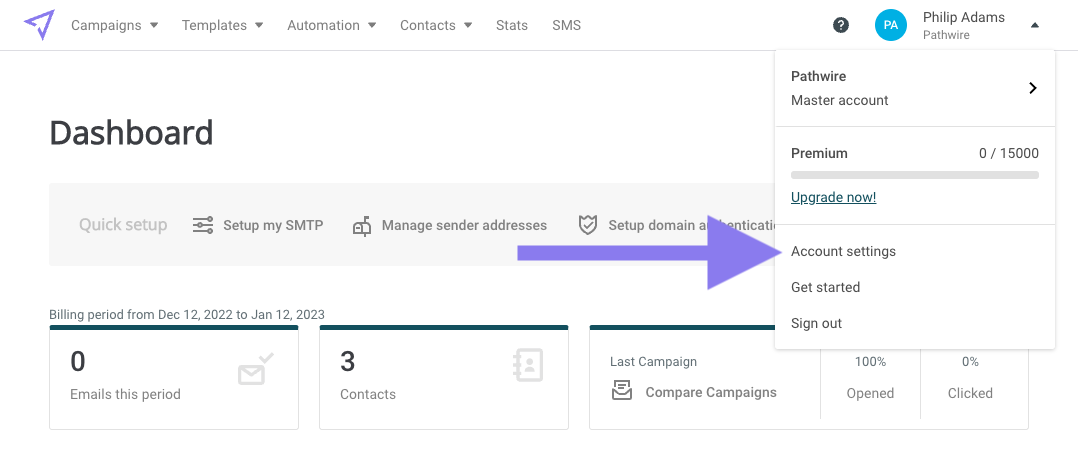
2) Click the “Create a segment” button.
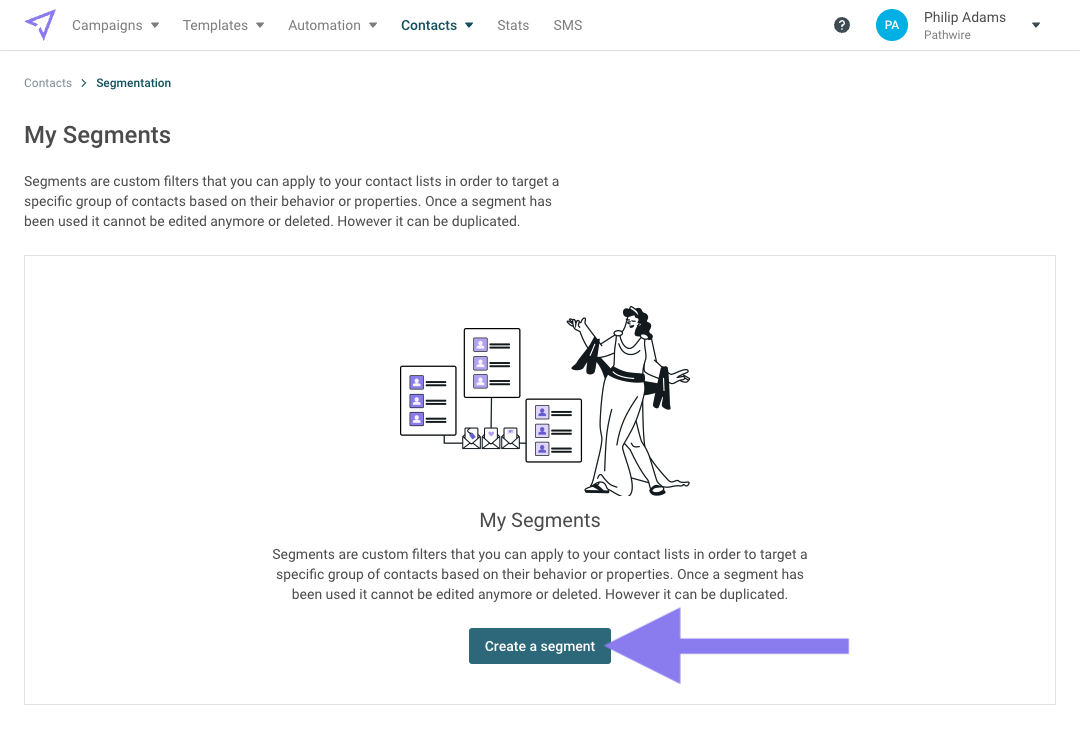
3) Enter a segment name and select your filters.

Click the “Calculate” button to apply the segment to your selected contact list and see how many contacts will be matched. When you have completed your segment, click “Create segment”. Now you can apply your segment to a campaign.
Create your campaign and when you select your contact list, you will have the option to “only send to a segment”.
Check out Sinch Mailjet’s full Email Segmentation documentation, as well as how to use Mailjet’s API to create email segments, to learn more.
Rome wasn’t built in a day. While email marketing segmentation can become a massive part of your email success, it’s important to start small. If you’re just starting your email marketing segmentation strategy now, don’t try to nail it all at once, simply identifyone segmentyou can create and begin testing.
From there, you can focus on new data that can inform more segments going forward. Do you have data assigned to subscriber purchase or user history? For B2B, do you have data on the size of the subscriber’s business? If so, maybe you can identify new segmentation opportunities and create your next segment.
In order to pull this off, you need an email marketing platform equipped with the right tools for the job. Mailjet is an email service provider that contains best-in-class contact list management tools as well as workflows to win back inactive users, and welcome email templates to onboard new customers.
What are you waiting for? Create your account today.